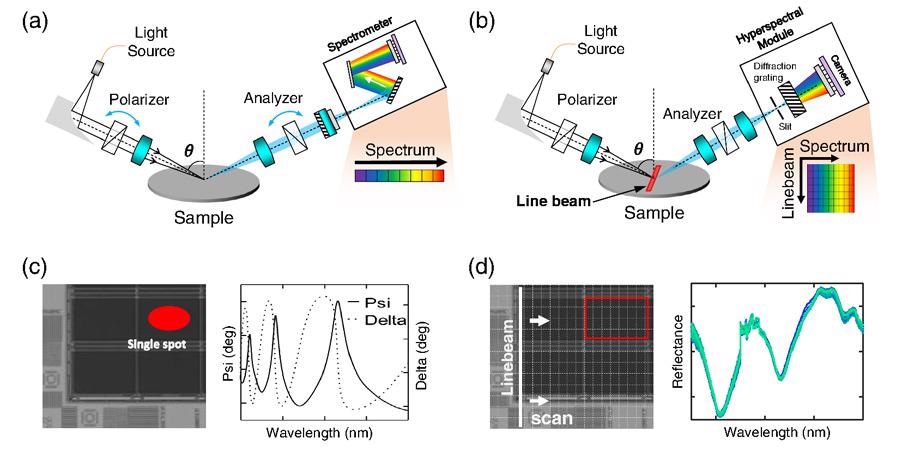Reviewed by Alex SmithApr 22 2022
Semiconductor fabrication technology has been steadily improving for decades and is now widely used in modern electronics. Semiconductors have shrunk to the size of a grain of rice, but they can now perform unprecedentedly complex functions. Manufacturing semiconductors at a scale of a few nanometers, on the other hand, presents a number of technical challenges.
 (a, c) The OCD spectroscopy approach. Though practical, it has limited spatial and spectral resolution and long scan times. (b, d) The LHSI approach developed by the research team, with a shorter scanning time and much higher spatial and spectral resolution. Each square in the grid shown in (d) corresponds to an observed “pixel.” Image Credit: Yoon et al.
(a, c) The OCD spectroscopy approach. Though practical, it has limited spatial and spectral resolution and long scan times. (b, d) The LHSI approach developed by the research team, with a shorter scanning time and much higher spatial and spectral resolution. Each square in the grid shown in (d) corresponds to an observed “pixel.” Image Credit: Yoon et al.
Manufacturers must ensure the uniformity of what is recognized as a “critical dimension” (CD) for semiconductor devices to function as intended. Manufacturing processes should be capable of reproducing the tiniest details of semiconductor structures all the way down to CDs because even minor flaws can cause devices to malfunction.
Admittedly, one of the major challenges in fabricating ever-smaller semiconductor devices is the lack of fast, reliable and accurate methods for measuring CD uniformity in cells, chips and wafers. Despite the fact that technologies such as transmission electron microscopy and atomic force microscopy have a high spatial resolution, their scanning speeds are too slow to be used in high-speed manufacturing.
There are quick measurement methods, such as optical critical dimension (OCD) spectrometry (which quantifies uniformity in semiconductor devices by analyzing the spectrum of light reflected off their surface). However, these methods frequently have a low spatial resolution, which puts them at a disadvantage.
In light of this, a team of scientists headed by Dr. Myungjun Lee, head of Samsung Electronics’ Inspection Solution Group, recently presented a new approach known as “line-scan hyperspectral imaging” (LHSI). This method may be able to address the issue of CD uniformity measurement speed and resolution.
The LHSI system is designed to deliver better resolution and throughput than OCD. The study was published in the Journal of Micro/Nanopatterning, Materials, and Metrology’s (JM) Special Section on Next Generation Light Source, Materials and Metrology/Inspection Equipment.
The way the surface of the semiconductor is scanned is the main difference between OCD and LHSI. The OCD system focuses a beam of light onto the wafer to create a bright spot. A spectrometer is used to capture the reflected light, and the resulting spectrum is examined. OCD systems have a low resolution due to the large bright spot, making it difficult to see minor details in the semiconductor structure.
The LHSI system, on the other hand, uses a narrow rectangular beam to illuminate the wafer’s surface, a technique known as “line scan.” The reflected rectangular beam is passed through a hyperspectral module, which is made up of slits, mirrors, gratings and cameras. The gratings decompose the incoming beam spatially into its constituent frequencies, which are then caught by cameras with different spectral ranges.
The cameras can capture the spectral information of every vertical “pixel” of the scanning rectangular beam in a single shot using the LHSI method. As a result, a massive quantity of data can be generated quickly, allowing CD uniformity measurements to be completed more in a shorter amount of time.
Our system enables the simultaneous collection of massive amounts of spectral and spatial information with an extremely large field of view of 13 by 0.6 mm2. Additionally, our method has an improved throughput of up to 10,000 times compared to the standard OCD method.
Dr. Myungjun Lee, Head, Inspection Solution Group, Samsung Electronics
The LHSI system has a spatial resolution of 5 μm and a spectral resolution of 0.25 nm over a wide range of wavelengths (350–1100 nm), in addition to its speed. The scientists were able to accurately view fine details on numerous semiconductor devices, surpassing other traditional approaches by a significant margin.
We believe that there is currently no technology other than LHSI that can be used to analyze CD uniformity at such high levels of throughput and resolution. It could be the tool we need to overcome current measurement limitations in the field of high-volume semiconductor manufacturing.
Dr. Myungjun Lee, Head, Inspection Solution Group, Samsung Electronics
Dr. Lee adds, “However, even though we successfully demonstrated the potential of LHSI, the critical modules, including a more stable light source, higher sensitivity cameras, higher precision optics, etc. need to be further improved by suppliers.”
On the whole, these results indicate that LHSI is a great alternative to one of semiconductor manufacturing’s most pressing issues. Optimizing this technology will help speed up the development and fabrication of semiconductors, lowering costs and enhancing the effectiveness of the electronic devices used every day.
Journal Reference:
Yoon, C., et al. (2022) Toward realization of high-throughput hyperspectral imaging technique for semiconductor device metrology. Journal of Micro/Nanopatterning, Materials, and Metrology. doi.org/10.1117/1.JMM.21.2.021209.